a guide to Pai, Mae Hong Son
Pai, in Mae Hong Son province, started to gain recognition in the late 1990s as a small city worth visiting when all thousands of curves en-route from Chiang Mai were a challenge and often scared anyone prone to motion sickness when road conditions were worse than what they look like today.
Yet its irresistible charm as a charismatic compact town in the valley with cultural dominance and natural grandeur prompted this gem destination to its stardom, firmly well-positioned on the international travel map.
Getting there
By Plane: The nearest airport to Phang Nga province is the Phuket International Airport – where the local carriers operate daily flights on the Bangkok-Phuket route. From the airport, you can get a rental car or private transfer to your beach destination in Phang Nga. Natai Beach is only a 30-minutes drive north of the airport, while the northern-most beach of Bang Sak is about 90 minutes’ ride from the airport.
Getting around
By Plane: The nearest airport to Phang Nga province is the Phuket International Airport – where the local carriers operate daily flights on the Bangkok-Phuket route. From the airport, you can get a rental car or private transfer to your beach destination in Phang Nga. Natai Beach is only a 30-minutes drive north of the airport, while the northern-most beach of Bang Sak is about 90 minutes’ ride from the airport.
Things To Do in Pai, Mae Hong Son
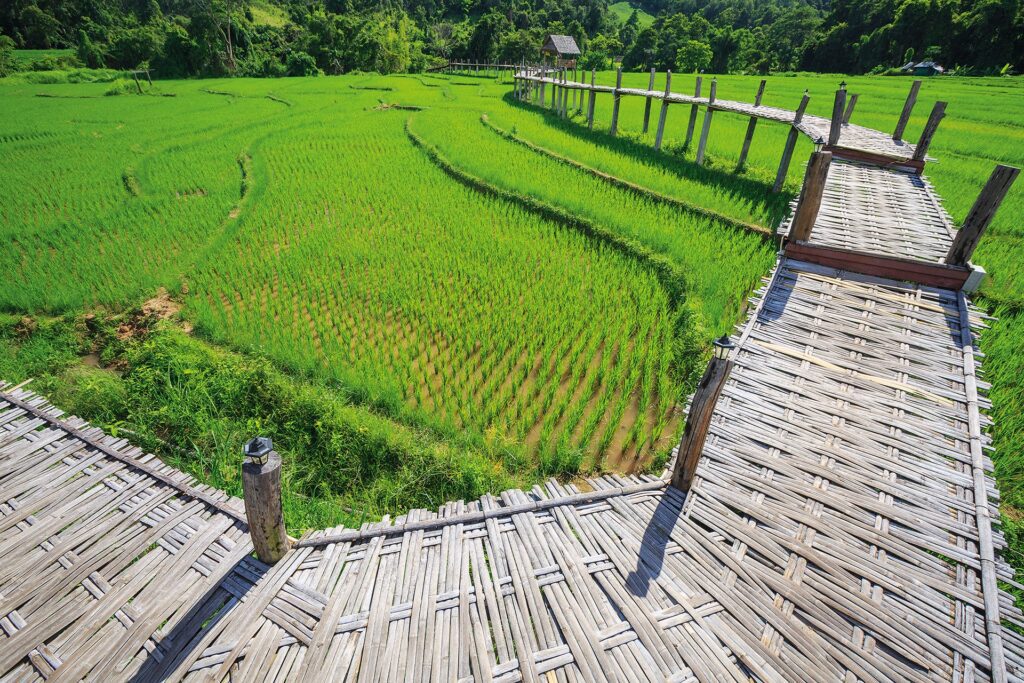
Kho-Ku-So, also known as the ‘bridge of merit,’ is the testament of a firm belief in Buddhism by local villagers of Ban Paem Bok. Most of the villagers are farmers of Tai Yai descendants, who in 2016 made a joint effort to build this bamboo walkway. The walkway winds through their rice fields to shorten the time monks would use on their morning alms mission traveling from the nearby temple to the village and vice versa. Hence the new landmark of Pai. Before, monks had to walk 6 kilometers from the temple to the village.
Walking along the bridge leads you to different sections of the rice paddies with mountains in the background as far as the eye can see is enjoyable enough. An early morning visit will allow you to see a line of monks as they graciously cross the bridge, while a longer queue of villagers wait to place food alms in their bowls. Feel free to join the locals if you happen to bring some food with you. Yoga and other activities are often arranged as well. A visit to the café for a drink to chill out watching the green fields before leaving is not a bad idea at all.
The Kho-Ku-So Bamboo Bridge is located 11 kilometers south-west of Pai, a short drive from Pai town center, on the same road that leads out to Pam Bok Waterfall and there is now a small charge (20 Baht) to walk over the bridge. Be there early before 6 AM if you want to witness or be part of the daily morning food alms offering ritual. Otherwise, you can visit the place all day long.
Contact Ban Pam Bok local tourism community at (+66) 63 123 9022 for more information on activities they arrange to ensure you won’t miss anything you plan to do.
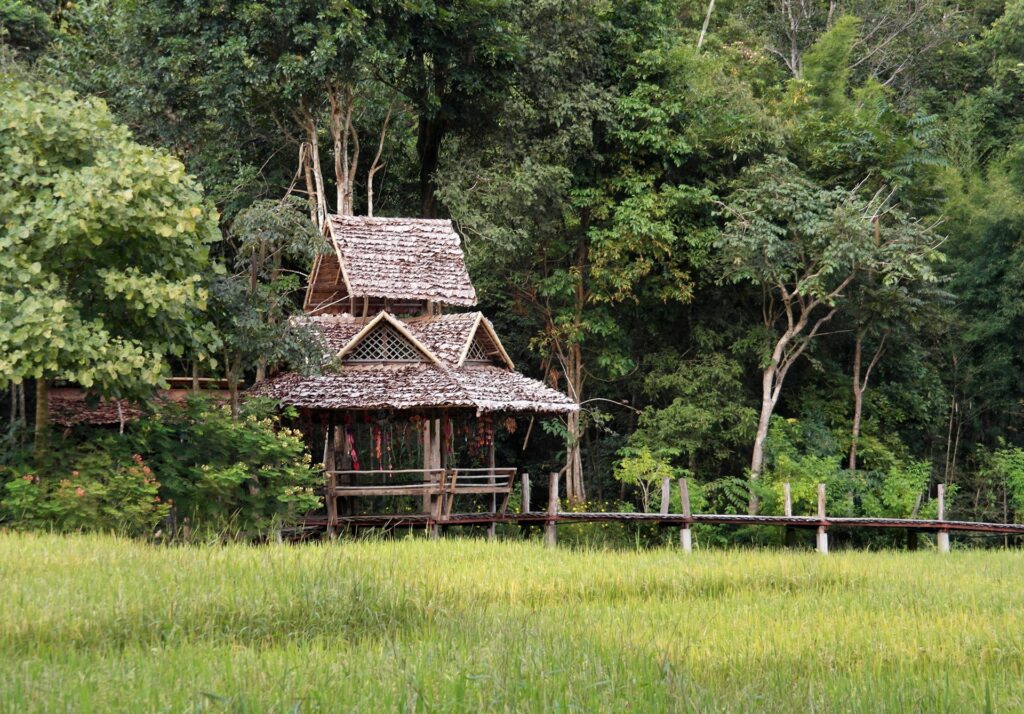
Pam Bok Village is one of the intriguing communities in Mae Hong Son which manages to harmoniously blend tourism of people from the outside world and the local ways of life together in a way that is sustainable and benefits the villagers. An overnight homestay in the village is another option to spend more time here to enjoy a breathtaking clear blue sky by day and a blanket of stars by night. It costs only 150 Baht per person (food not included).
A lot of visitors are growing fond of having a chance for any first-hand experience when it comes to trying something new. Once at Kho-Ku-So Bridge, feel free to learn the art of rice farming. Make sure you plan to visit the area during the green season or no later than November when the rice fields are green and ready for the harvest if you want to learn how it feels to set foot on the paddies as a farmer.
Contact the same Ban Pam Bok local tourism community at (+66) 63 123 9022 or call (+66) 95 189 7082 to inquire about accommodations, a tent campsite, and trekking.
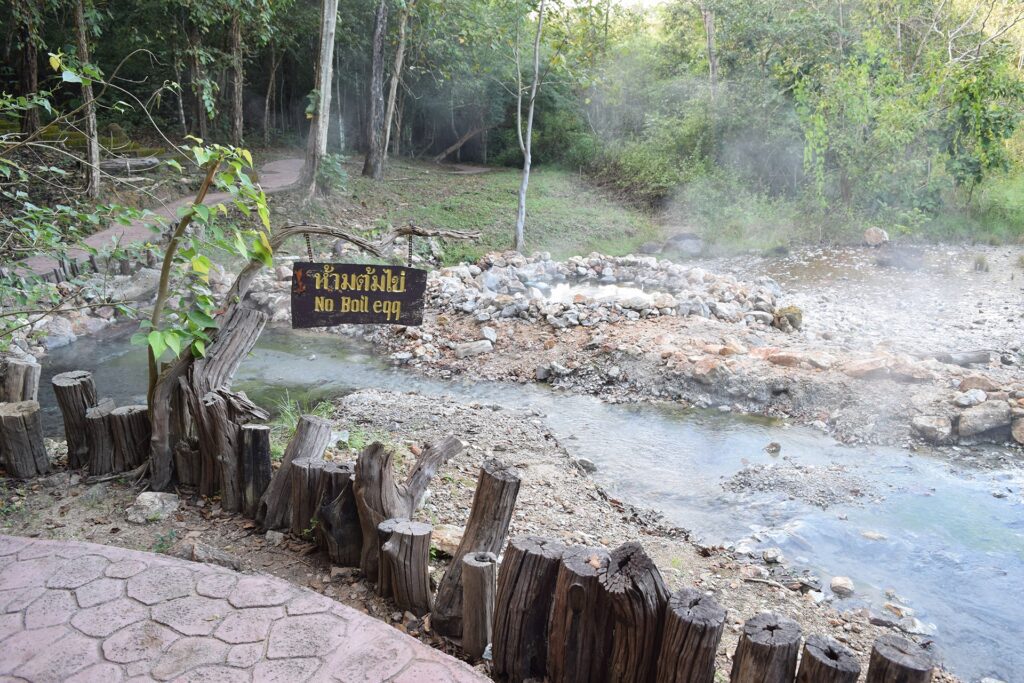
Blessed with several thermal springs, Pai is one of the best resort towns to treat yourself to a relaxing dip into warm crystal-clear water, especially if you’re there during the cool season. Pick any hot spring you prefer, from a public or any affordable one to a hot spring resort offering a luxury private jacuzzi, your muscles will be thankful.
If you’re indecisive as to where to go, head to Ta Pai Hot Spring, the most popular one located approximately 8 kilometres south of Pai town centre and is not very far from Pai Canyon. Apart from different baths at 34 to 38 °C, take a stroll in the park up along an easy path leading to the spring with the water warm enough to boil eggs as locals often do. Bring your eggs if you want to prove it.
Ta Pai Hot Spring is open daily from 7 AM – 6 PM. The entrance fee is 300 Baht for foreigners. The place doesn’t look fancy if you compare it to other privately-own thermal springs but the price is affordable and the no-frills service is satisfying.
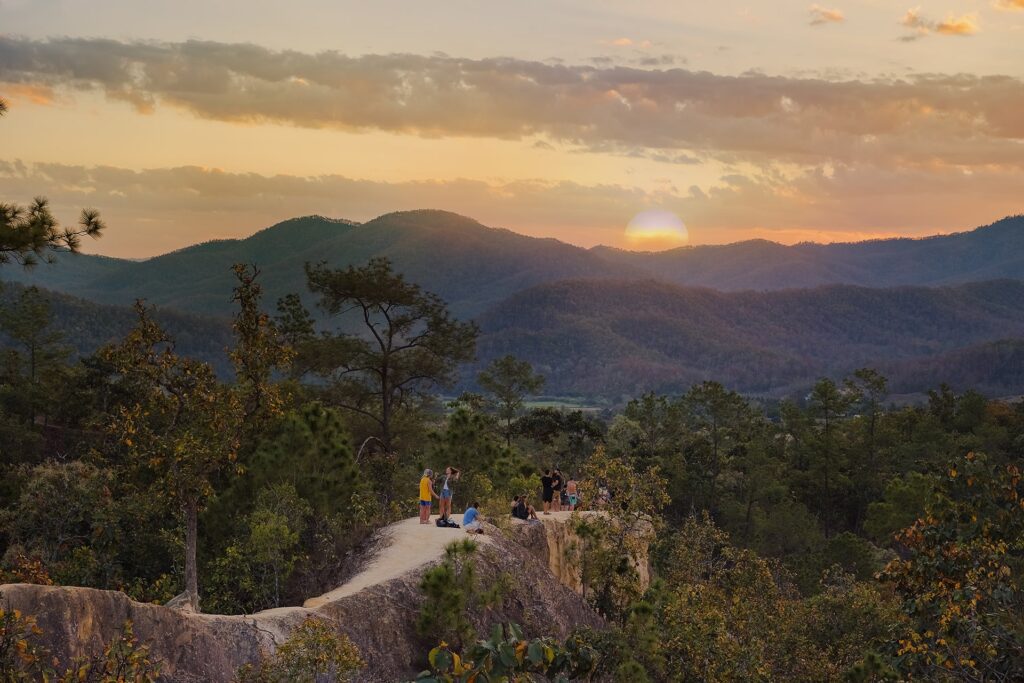
Drawing a huge number of visitors daily, the natural wonder of Pai Canyon (or Kong Lan in Thai) makes it one of the most popular attractions in this small town. The unique area has been formed by continuous erosion over decades before reaching the current condition. Though not big like the term ‘canyon’ often leads you to imagine, the geological formation has its fair share of spectacular grandeur and the views up there are excellent. It’s also large enough for you to find your quiet corner to sit and embrace the scenery. Geological magic of the area offering an awesome 360° panorama makes Kong Lan one of the most scenic spots to enjoy the sunset while it can be enjoyed at sunrise too.
An incredible place with unique landscapes to explore, Pai Canyon is easily accessible to anyone; it’s just a 5-minute walk to the top from the car park, which is usually crowded before sunset. More adventurous tourists usually explore many different tracks. Hiking around the canyon won’t take more than a couple of hours. Be sure to take precautions due to the lack of railings since the paths leading further vary widely in width and steepness. It takes somebody who’s sure-footed and not faint-hearted to trek along the narrow serpentine path of the canyon, with tens of meters down on each side. If you’re not, stay away from the edge.
Pai Canyon is located 8 kilometers south of Pai on Highway 1095, not far from Pai Memorial Bridge. No entrance fee will be charged. The best time of the day to go there is 5:30 PM to allow yourself some time to wait for the sun to come down. In the cold season, it usually sets early, sometime before 6 PM.
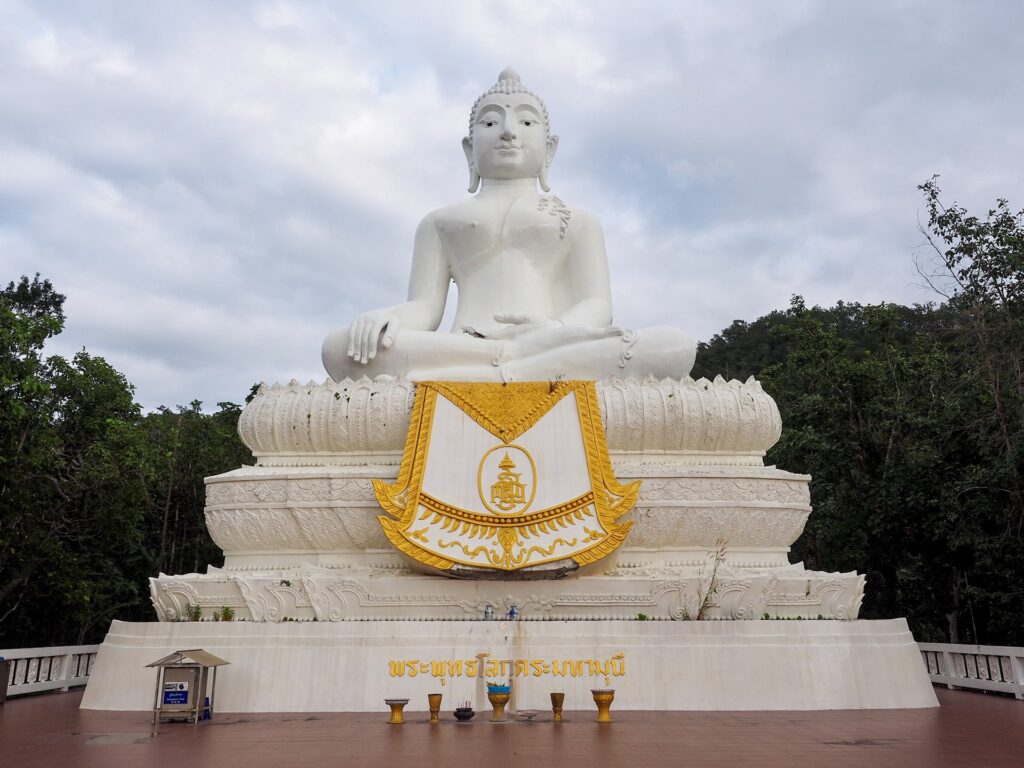
If not at Pai Canyon, then Wat Phra That Mae Yen with the giant White Buddha is the ideal location to watch the sunset. It has become a not-to-be-missed spot here in Pai. Mae Yen is a small quiet temple and even today there are only a couple of monks residing here. The highlight of the temple, the White Buddha, facing the west making the area idyllic for a sunset view, is an imposing presence from Pai town center about 2 kilometers away. What’s challenging is the 353 steps to the top. The place is normally closed at 6 PM and one hour before that, locals and foreigners start to go up and occupy a perfect seating on the steps. The top area where the Buddha is located has a wide-open space to rest. Some of those who go there early often sit cross-legged meditating while others sit still and have some quiet small talks while waiting for the spectacular scenery of the sunset over Pai Valley.
Close to Pai town center, Wat Phra That Mae Yen is easily accessible and within a walking distance. Take the main street towards Chiang Mai, cross the bridge and look for signs to “Wat Phra That Mae Yen” on the left side. You won’t get lost going there in the late afternoon with many people heading there too.
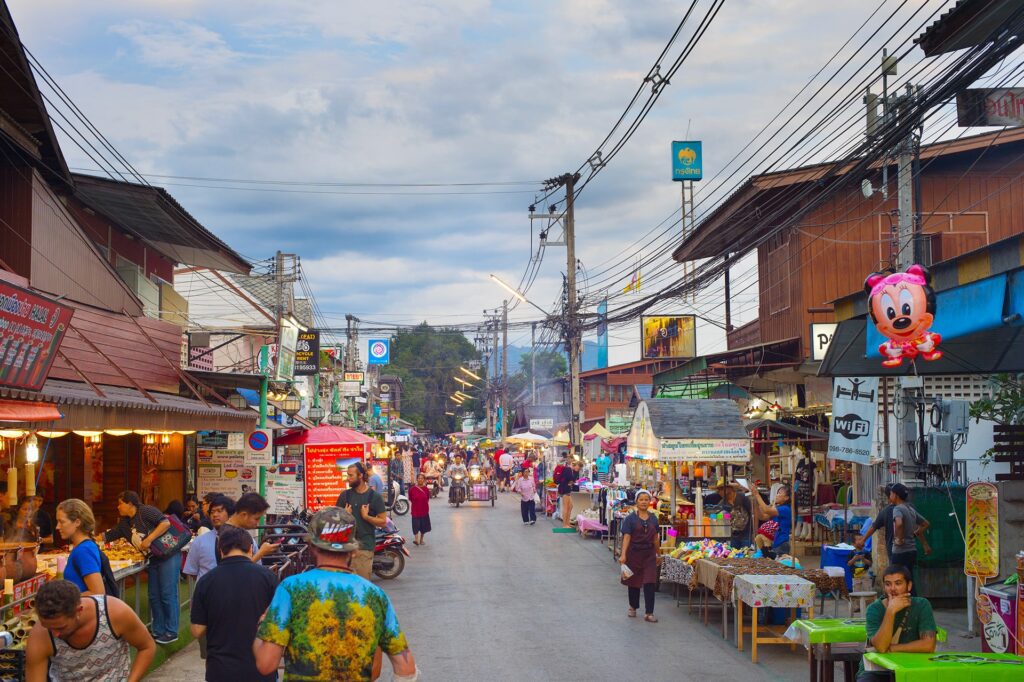
The perks of staying in town whenever you visit Pai is getting to enjoy the walking street market every single day with just a short walk from your place. During the early morning, the whole town is quiet and braves the cold weather for everyday routines, and it starts to get busier as the day goes by.
During the late afternoon, some locals will be ready to turn main roads in the town center into the whole ‘walking street’ market with some setting up stalls or spreading the canvas to put their products on display along the road while some closing their daytime shops only to reinvent it into another business such as a BBQ eatery, a fruit station, and a smoothie and juice bar. One of the most charismatic characteristics of Pai is that you get to witness the multi-cultural co-existence with the Muslim mosque located in the town center surrounded by Thai locals and those of Chinese descendants harmoniously sharing the same lovely community. Muslim visitors can rest assured there will be plenty of halal food to choose from. Shopping enthusiasts will be pleased to barter their way to the best price as they select any products from roadside stalls, ranging from t-shirts and traditionally-dyed fabric to jewelry and paintings.
As you explore the area, pick any restaurant to enjoy your dinner. Anyone not keen on sitting down at a particular place will find it’s fun enough to buy local foods from different stalls and eateries, especially if you come here with friends, and nibble a little bit of this and that while walking along, enjoying Pai’s lively nighttime as opposed to its quieter atmosphere during the day.
The walking street market starts around 6 PM till 10 PM, though some bars stay open till 11 PM or midnight.
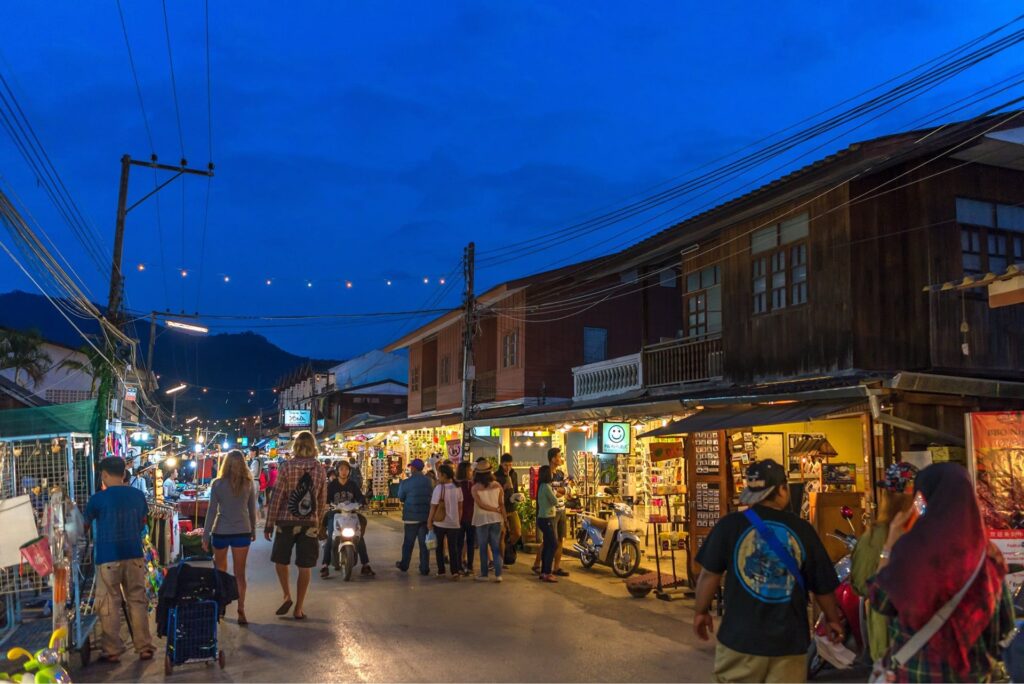
While most of the local visitors can still indulge themselves in the slow living ideology as they stroll around this small quiet town which has become more crowded than it was decades ago, what makes Pai famous in a different way is the scene of foreigners flocking the main roads and local bars and food stalls at night. An influx of western visitors during the last two decades has turned what used to be a no-nightlife town into one of the most charming places for nighttime gathering in Northern Thailand, as Pai has a section of the walking street where you can sit and enjoy live music from different bars.
From the town’s bus station on Chai Songkram Road down to Tesaban 1 Road, there are many pubs to choose from. Don’t Cry Bar is the first one you will notice, while Pai Siam Bar & Bistro is one of the most crowded places. Before you reach the end of the road, a small section of street on the left passing Wat Pa Kham leads to Jazz House (check out their Facebook page) , which has the most relaxing and greatest ambience that will probably inspire you to enjoy music and drinks even more.
For health-conscious travelers, Malamong Art Café serves a variety of tea, easily noticeable with hippie-like patrons sitting on small low stools and engaging in their conversations.
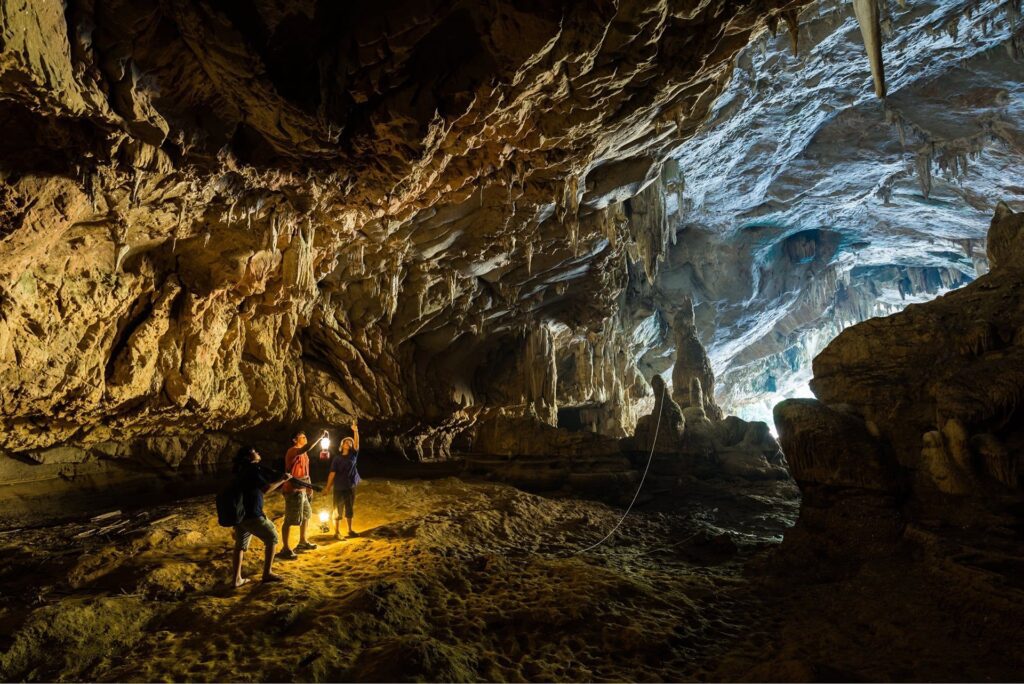
In case you have some free time and are keen on cave explorations, a visit to Tham Lod, or Tham Nam Lod, is then worthwhile since it takes an hour to drive up and down the mountains to go there. Located in Pang Ma Pa District, the 1.6-kilometer-long impressive limestone formation of Lod Cave, one of many in Pai area, is the perfect example of how a local community takes great care of their natural assets. All the guides are local villagers who are trained to explain the rock formations and important spots inside. The main entrance is impressive and best viewed from the inside. Your guide with a lamp in one hand will lead the way through different sections along small alleys inside the dark cave, climbing up and down some steps along the way. The light from the lamp allows visitors to see mysterious and beautiful images formed by stalagmites and stalactites inside the dark cave, definitely with a little help from your imagination.
It takes an hour for the cave exploration alone. Spare another sixty minutes if you’re keen on rafting on a small bamboo boat controlled by two local villagers who will take you on a short cruise along the Nam Lang River flowing through the cave. You can choose to explore the cave by boat for three hours. You may feed the fish along the way if you happen to buy their food at the reception as you pay for an admission fee of 400 Baht for both the cave exploration and the boat. On the way out, you will probably notice some bird watchers eager to spot local swifts making their way home at twilight after a long day, while a colony of bats will fly out of the cave looking for food.
Located at Tham Nam Lod Wildlife and Nature Education Centre in Tham Lod Sub-district and under the supervision of Lum Nam Pai Wildlife Sanctuary, the cave is open daily from 8 AM to 7:3o PM. Though accessible all year round, only the first chamber of the cave will be open during the green season while the other two will be closed due to high water levels. What is so special about the place is how they engage local people to be part of the tourism, with local guides collecting 90% of what visitors pay while 10% goes to the wildlife sanctuary.
It’s better to be well-prepared for cave exploration. Sneakers, not sandals, are recommended. If you come as a group, no more than 3 persons per guide, and you might as well bring your flashlights. A tripod is useful in case you need good photo shots inside the dark cave.
Since the officials of the park are mainly local, you are recommended to book through agents instead of calling the Wildlife and Nature Education Center directly. A better way is to contact the Tourism Authority of Thailand, Mae Hong Son Office via email at tatmhs@tat.or.th
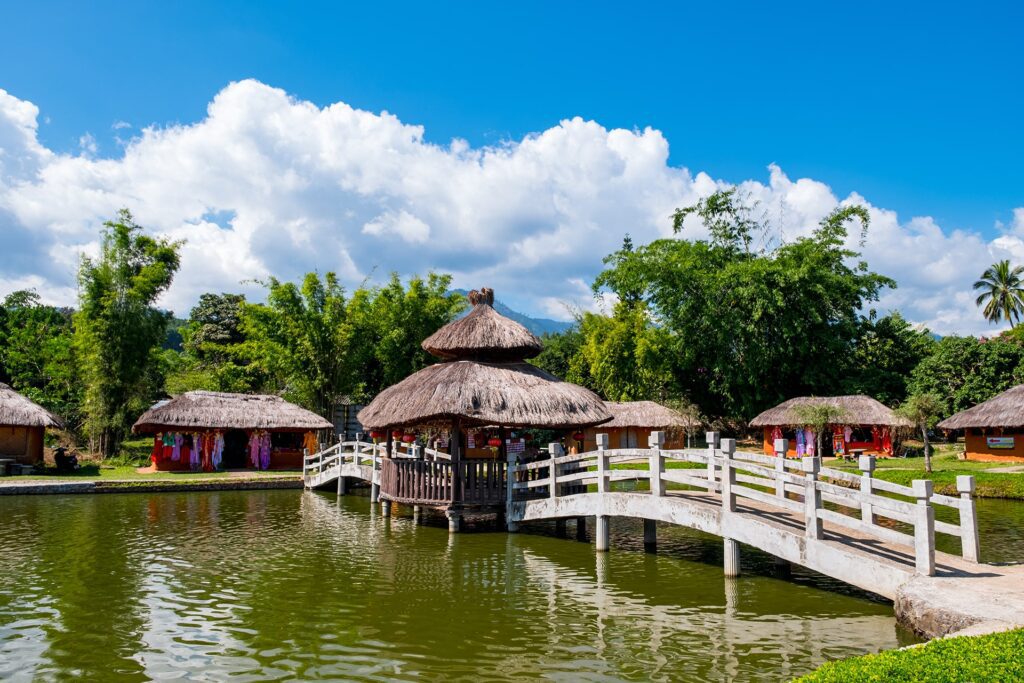
Mae Hong Son is known as the land of cultural diversity with ethnic groups from different backgrounds and the Chinese Yunnan Cultural Village, one of many in the province, is a manifestation of Yunnan influence still playing a vital role socially and culturally. Historically, the area was settled by Chinese people who fled the Mao Tse Tung revolution and their descendants still live here after all these years, maintaining their traditional way of living while also profiting from Pai’s economic boom due to growing tourism. Built to help solve drug problems in the community since opium was widely grown in the North of Thailand decades ago, the village called Santichon in Thai looks exceedingly exotic as a tourist spot, the one that draws your attention upon your first step inside.
The place is like a theme park, arranged in different sections, with surroundings that appeal in many ways. Close to the entrance, two main restaurants with structures made from straw and mud serve typical Yunnan food with highlight dishes being yummy pork knuckle and steamed Chinese buns, which is somehow too much for one to eat alone, and fried noodles. Small souvenir shops built like mud houses provide traditional Yunnan costumes for rent for those wishing to be photogenic enough. Their colors are a feast for the eyes too for those who wish not to rent any. Some activities visitors can enjoy include a Wooden Ferris wheel, archery, and mule riding. A section of the Chinese wall replica is a huge attraction. A small flower farm at the end of the village adds something different and more natural.
A few kilometers beyond the village, you will find a place that offers breathtaking panoramas of Pai Valley. Yun Lai Viewpoint is arguably the best location to witness the sunrise in Pai. Be there early. If you drive, you’re supposed to leave your vehicle at the village for safety reasons, since thick fog can be expected at dawn making it difficult for anyone not familiar with the steep and bumpy route to go on their own. Local trucks are there to take visitors up the mountains. Scooters can go all the way through. The breathtaking scene is worth getting up early for.
The touristy Chinese Yunnan village is located in Wiang Tai about 4.5 kilometers outside of Pai. It’s open 7 AM – 6 PM. Take the hospital road on the west side and follow it until you reach the Bypass Road. Go pass Wat Nam Hoo and cross the bridge with a large Chinese gate to enter the village. From there you can take the bumpy road uphill to the top to Yun Lai Viewpoint. Make sure you reach there by 5:30 AM, just in case the sun comes up early. Normally 5:45 AM is fine.
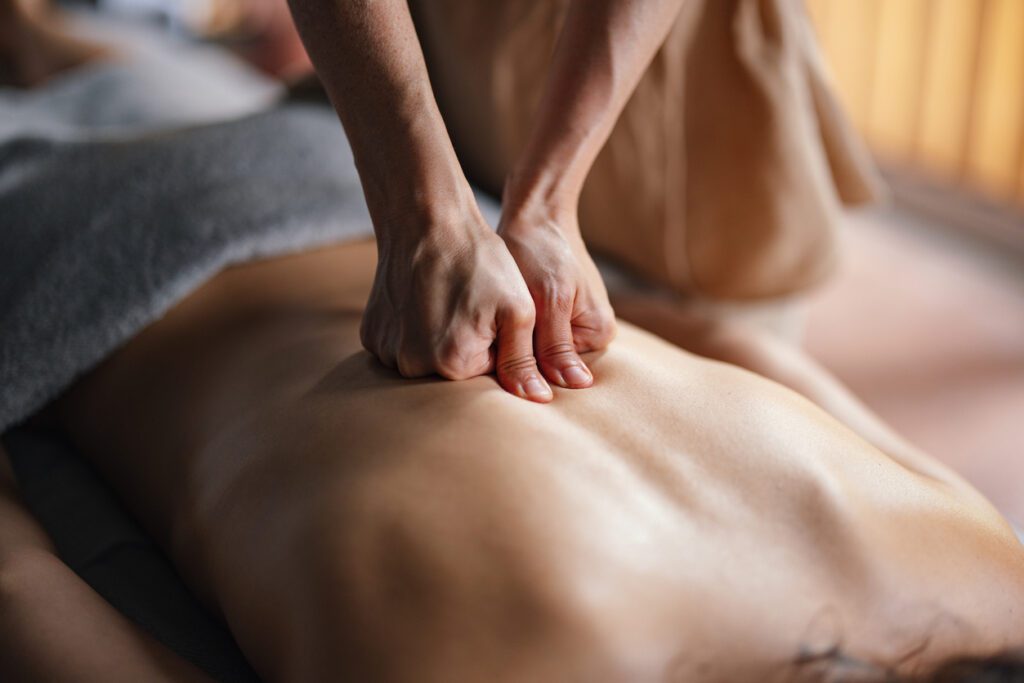
With traditional Thai massage listed as a UNESCO ‘intangible cultural heritage’ in late 2019, services at Sapaiya Spa and Clinic should be in higher demand. This massage parlor and aesthetic spa, the only premium one in Pai, earned a Certificate of Excellence from TripAdvisor and won DBD Wellness Service Award Best Practice 2018, among others, is a real treat in this laid-back town. The place is cozy and relaxing and the service is wonderful. Treat yourself to a traditional or other massage and you realize how one hour of pampering your muscles can work wonders.
Sapaiya, which won the coveted Thailand Tourism Award and provides a variety of standard massage and aesthetic treatments using only organic products, is open daily 11 AM – 10 PM, located at Wiang Tai, close to the Wednesday market. Check their website for appointments.

This small community got its name from the towering over 100 years old bodhi trees in its main yard. They call themselves ‘Phoromraun’ meaning ‘shady bodhi trees’ and the area lives up to its name, making you feel relaxed and at home the first time you lay your eyes on those eye-catching plants. Located close to the Sapaiya Spa, the area is surrounded by café houses, restaurants, and hotels with a common playground with huge trees providing shades for whoever prefers to lie down under. Across the playground is a huge square which would turn into a local early morning market on Wednesdays where fresh produce will be available. Khaotha Café sits in the perfect corner luring passers-by to come in for a drink to cool off in the afternoon. Tourists staying at hostels here can enjoy more privacy than the ones located in main streets and some prefer this area and opt to go into town center which is within a walking distance for a glimpse of nightlife only.
One recommended place is Good Life Da Cha which offers accommodation, with food and drinks available, and organizes half-day ‘art of wild fermentation’ workshops where you learn how to ferment tea leaves for tasty and healthy kombucha. They also have a sauna bathing service for anyone interested in relaxing while achieving benefits that include detoxification, increased metabolism and blood circulation as well as skin rejuvenation, among others. Check out their Facebook page and website.
The community is suitable for a visit any time of the day from morning to twilight, although a relaxing care-free afternoon is ideal.
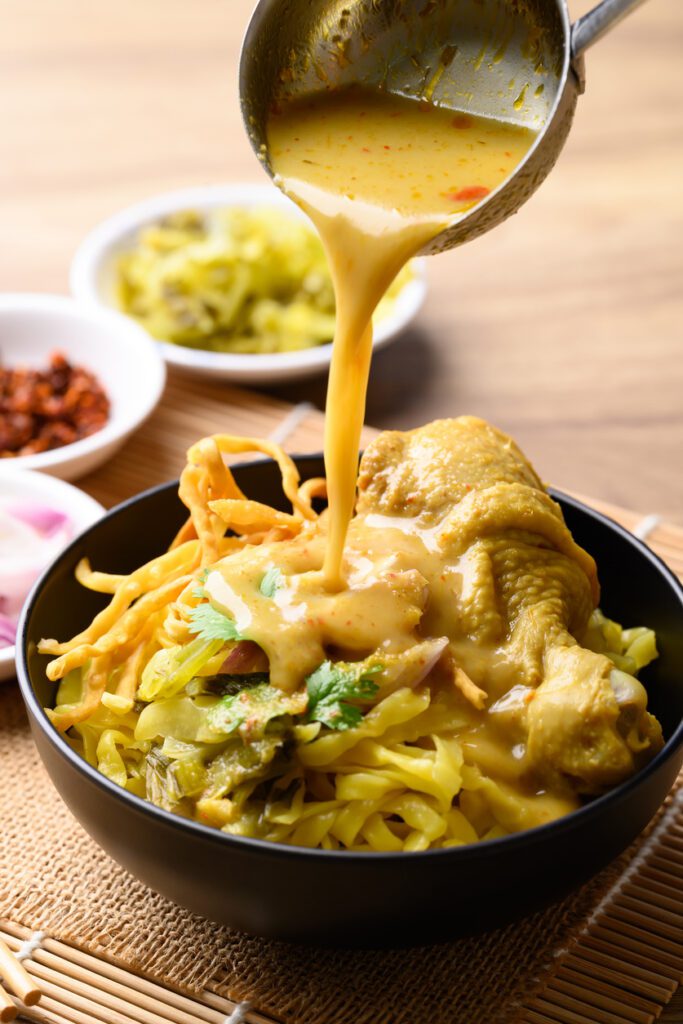
Pai is a typical town where locals favor vegetables, as some farmers grow fresh organic produce, with some restaurants make a name for themselves serving vegetarian food. Meanwhile, Yunnan fried noodle, Tai-Yai recipe Khao Soi (egg noodles in curry-like soup) and Khanom Jeen Nam Ngeow (spicy soup served with rice noodles and minced pork curry with tomatoes) offer some flavors to remember Pai by.
Baan Benjarong at Pai is the first and original branch of the home-based restaurant set up by a couple to preserve the heritage of their regional Thai cuisine including vegetarian dishes. The second location was opened in Nonthaburi in 2017 which later received the Bib Gourmand status by Michelin Guide. They serve original Thai food at lunch and dinner (11 AM -1 PM & 5 PM – 8 PM). The restaurant is located on Rangsiyanon Road, not far from the town center.
Khao Soi Zister’s in Wiang Tai Sub-district serves delicious Khao Soi and Khanom Jeen Nam Ngeow, all from grandma’s recipes, in a cozy ambiance. Two sisters run this place and a resort nearby, hence the name of the restaurant. Each of their dishes is served in big portions but it’s recommended you taste both Khao Soi and Khanom Jeen Nam Ngeow. Choose tofu instead of meat if you feel like going vegan. Their coffee tastes great, too.
Nong Beer takes advantage of being close in the town center at one end of the walking street serving a variety of food from Khanom Jeen Nam Ngeow, Khao Soi, satay and everything tourists would become mouth-watering at the mention of their names.

